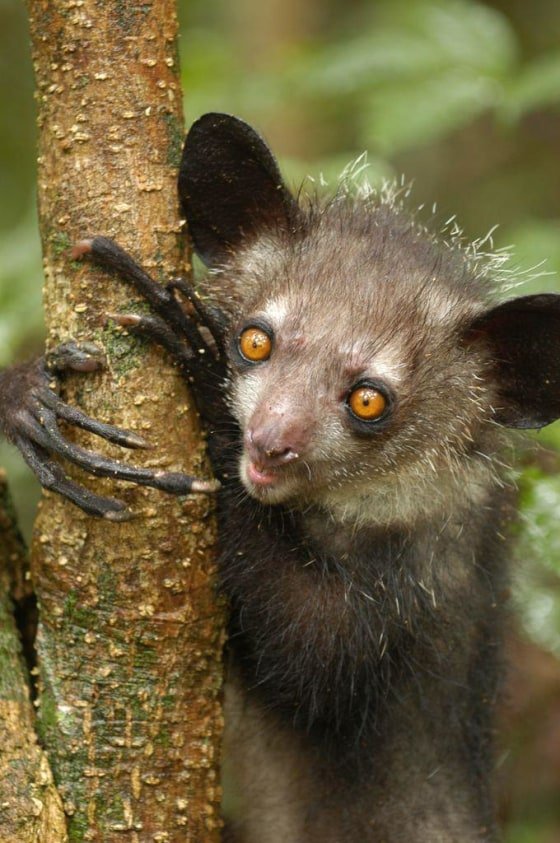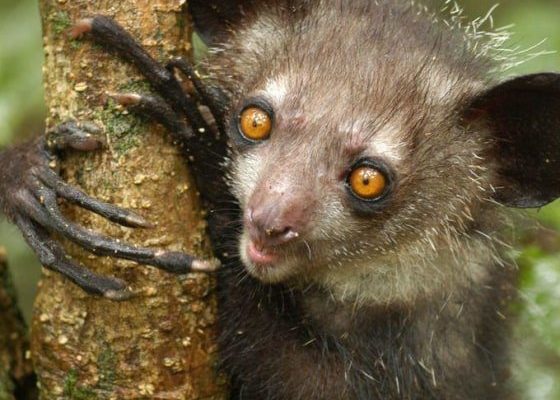
Imagine the aye-aye as a living puzzle that scientists have spent years trying to piece together. It’s a creature that showcases evolution in action, demonstrating how animals can adapt over millions of years to survive and thrive in their environments. From its specialized feeding habits to its intriguing family lineage, the aye-aye’s story is one of survival against the odds. Grab a cup of coffee, and let’s dive into the captivating world of this extraordinary primate!
What is an Aye-Aye?
The aye-aye (Daubentonia madagascariensis) is a species of lemur, and unlike most other lemurs, it’s primarily nocturnal. This means it’s active at night when most of its predators are sleeping. Aye-ayes are best known for their distinctive features, particularly their extraordinarily long middle finger. This unique digit isn’t just for show; it plays a crucial role in how these animals find food.
Here’s a fun fact: the Aye-aye can tap on trees to locate insects hiding beneath the bark, a behavior similar to woodpeckers! Once it hears a hollow sound, it uses its long finger to dig in and extract the tasty treat. You might be wondering why they evolved to have such a peculiar hunting technique. The answer lies in their environment and food sources. Madagascar’s unique ecosystem has shaped the aye-aye’s adaptations over thousands of years.
An additional characteristic that sets them apart is their large, expressive eyes, which help them see in low-light conditions. This feature is essential for their nocturnal lifestyle. All these adaptations come together to highlight just how specialized the aye-aye is in its ecological niche.
The Aye-Aye’s Place in the Primates Family Tree
To understand the aye-aye, we need to look at its family tree. The aye-aye is part of a subgroup of primates called strepsirrhines, which also includes lemurs, lorises, and galagos. Strepsirrhines are characterized by their wet noses, which give them an excellent sense of smell. Within this group, aye-ayes belong to the Indriidae family, which also includes the indri, a larger lemur.
Here’s the thing: the aye-aye represents its own genus, Daubentonia, and holds a unique position within the primate world. Unlike many primates, which are closely related to each other, the aye-aye’s evolutionary path diverged, making it quite distinct from other lemurs. Scientists believe that the aye-aye branched off from other lemurs around 60 million years ago, adapting to its unique lifestyle in Madagascar.
By examining the evolutionary history of the aye-aye, researchers can glean insights into how primates have evolved in response to their environments. The diversity of traits, such as their long fingers and nocturnal habits, illustrates the complex interplay between genetics, adaptation, and survival.
Adaptations: How the Aye-Aye Survives
Adaptation is a fascinating aspect of evolutionary history. The aye-aye has developed several key traits that help it survive in the wild. For instance, its elongated middle finger is not just a quirky feature; it’s an essential tool for finding food. This finger allows the aye-aye to tap on trees, locate grubs, and extract them efficiently.
Another adaptation is its large, sensitive ears. These help the aye-aye detect sounds, such as the movements of insects beneath the bark. This combination of sight, hearing, and touch is vital for a successful night of foraging. With a diet that mainly consists of insects, fruits, and nuts, these adaptations ensure the aye-aye can thrive in the competitive forest habitat of Madagascar.
You might be wondering how these creatures cope with environmental changes. The aye-aye’s flexibility in diet—being opportunistic feeders—allows them to switch to different food sources when necessary. For instance, if insect populations dwindle, they can rely more on fruits and seeds. This adaptability is crucial for survival, especially in a habitat like Madagascar, which faces challenges like deforestation.
The Aye-Aye’s Unique Reproduction
Reproduction in aye-ayes is another interesting aspect of their evolutionary history. These primates typically reach sexual maturity between two to three years of age. They have a relatively low reproductive rate, often giving birth to a single offspring every two to three years. The young are cared for primarily by their mothers, who provide them with essential skills for survival.
The aye-aye has an interesting mating ritual, which includes vocalizations and scent marking to attract potential mates. Unlike many mammals, aye-ayes do not form long-term pair bonds, so mating often occurs seasonally. This flexibility allows them to find mates in a less competitive environment.
Interestingly, the survival of aye-aye offspring is often tied to environmental factors. For example, in areas with abundant food sources, young aye-ayes have a better chance of thriving than in regions where food is scarce. Scientists are studying these reproductive patterns to understand better how changes in their environment impact their populations.
Conservation Status: Challenges and Efforts
Sadly, the aye-aye faces several challenges. Due to habitat loss and hunting, populations of aye-ayes have been declining. Deforestation for agriculture and logging threatens their natural habitat, forcing them into smaller and more isolated areas. The International Union for Conservation of Nature (IUCN) has categorized the aye-aye as “Endangered,” highlighting the urgent need for conservation efforts.
Community education and conservation programs play a crucial role in protecting aye-ayes. Local communities are being involved in conservation initiatives to ensure that these unique creatures have a chance to thrive. For example, eco-tourism can create economic incentives for locals to protect the aye-aye and its habitat rather than exploiting it.
Here’s the thing: raising awareness about the aye-aye is essential. Many people still view them with superstition due to their odd appearance, often associating them with bad luck. Educating communities about the aye-aye’s ecological importance can help change these perceptions and foster a more supportive attitude towards conservation.
The Future of the Aye-Aye
The future of the aye-aye hinges on a combination of conservation efforts, habitat protection, and community engagement. Scientists are working diligently to monitor populations and understand their needs in a changing environment. New technologies, such as remote sensing, are being used to track habitat loss and foraging behavior, providing valuable data for conservation strategies.
Effective strategies include establishing protected areas, engaging local communities, and promoting sustainable practices. It’s a team effort that involves scientists, conservationists, and local people all coming together to support the aye-aye and its habitat.
In the long run, the aye-aye’s survival may depend on our understanding of its evolutionary history. The more we know about its adaptations and challenges, the better equipped we are to support its conservation. This unique primate not only adds to the incredible diversity of life on Earth but also serves as a reminder of the delicate balance required to maintain that diversity.
In conclusion, the aye-aye is a remarkable example of evolution at work. Its peculiar adaptations and unique lifestyle tell us a lot about survival, adaptation, and conservation in our changing world. By learning about and supporting these captivating creatures, we can help ensure that they continue to thrive in the wild for generations to come.

